Abstract
The Late Paleozoic is an important epoch of coal-bed accumulation in the North China, particularly in its western segment, where a world-class coal field has been found and exploited for three decades. Coal-bearing layers recorded rapid Late Carboniferous to Early Permian sea-level rise that led to the evolution of the shallow marine tidal flat basin, followed by regression that resulted in the formation of deltaic facies. However, little attention has been paid to the tectonic factors that assisted in the coal accumulation processes, which have been demonstrated worldwide to be pivotal. In this study, we evaluate the significant influence of southward subduction of the middle segment of the Paleo-Asian Ocean (PAO) during Carboniferous to Early Permian deposition of coal-bearing neritic to deltaic successions in the western North China Block (NCB). We pinpoint a direct link between basin-filling evolution of the northwestern Ordos Basin and the progressive uplift of the Inner Mongolia continental arc triggered by the south-dipping subduction of the Solonker ocean plate. Sedimentary facies variation and paleocurrent reconstruction indicate sedimentary routing from the north to northeast. The petrology and detrital zircon geochronology of sampled sandstones indicate evolving provenances from a dominated cratonic basement to a mixed orogen and continental arc. The Carboniferous samples are generally quartz arenites and contain a large number of Archean to Paleoproterozoic zircons with small amounts of Paleozoic arc pluton components, indicating sediment supply dominated by the western NCB Precambrian basement. In contrast, the youngest sample of the Shanxi Formation is sub-litharenite, the age spectrum of which is characterized by the dominance of ca. 450 and 270 Ma ages, indicative of a high influx of Paleozoic arc detritus. This shift in sandstone petrology, detrital zircon distribution, and depositional setting allows us to link the shoaling of the Ordos Basin with mountain building and the unroofing of the continental arc, which enhances our understanding of both the subduction of the PAO and coal accumulation in the NCB.
1. Introduction
Among the important epochs of coal accumulation in the North China Block (NCB), Carboniferous to Early Permian neritic to deltaic sedimentation resulted in a large area and multiple coal beds [1,2], which serve not only as important coal resources but also as source rocks for Carboniferous to Permian natural gas in many oil fields of North China [3,4]. In addition, various rare elements have been found in these coal-bearing stratigraphic levels [5].
The Wuhai Coalfield, that is situated at the northwesternmost portion of the North China coal accumulating area (Figure 1), is famous for widespread Carboniferous to Early Permian coals, is one of the largest world-class coalfields. Aiming to improve the exploration and development of this coalfield, many efforts from the perspectives of sedimentology, structural geology, and engineering geology have been made [3,5], while, as a basic issue, the paleogeography and source-to-sink relation of the Wuhai Coalfield remain poorly understood, generally regarding the neritic to deltaic facies as expressions of cratonic subsidence of the NCB in addition to global late Carboniferous transgression [6,7]. However, it has been ignored that widespread volcanic tuffs have been found in this sequence [8,9], indicating a more active tectonic background in which the basin evolved [2,8]. In recent studies, petrologic and detrital zircon geochronologic attempts on Upper Paleozoic sandstones from the NCB commonly revealed a subduction-collision related setting for shallow marine to lacustrine basin in the NCB [2,10] and further hinted that subduction and closure of the Solonker Ocean in the southern Paleo-Asian Ocean should have dominated the geologic history of the NCB and basin system on its surface [11].
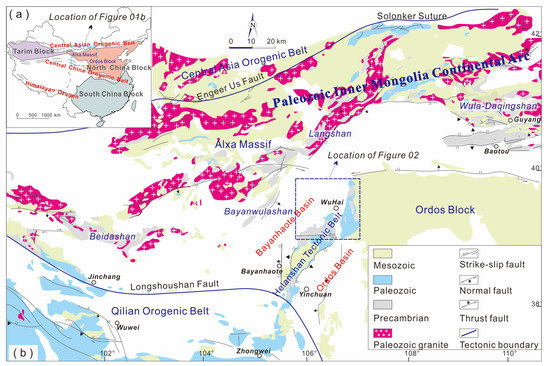
Figure 1.
(a) Simplified map illustrating tectonic framework of the China mainland; (b) Tectonic overview map of the western North China Block showing the location of the Alxa Massif, Ordos Block, and the Paleozoic Inner Mongolia Continental Arc [2].
In this study, we present new sedimentological, petrological, and detrital zircon geochronological data for sandstones from the Upper Carboniferous to Lower Permian successions in several locations in the Wuhai Coalfield, with the aim of revealing the influence of arc mountain building in the northern NCB flank in both sediment supply and dynamic interaction with basin and paleogeographic evolution of the western NCB. This new insight significantly improves our understanding the tectonic background of the coal-bearing terranes in the NCB during late Carboniferous to early Permian.
2. Geologic Background
2.1. Structural and Stratigraphic Outline
The NCB is a heterogeneous collage of four mircotetranes sutured by three orogenic belts at ca. 1.95 Ga [12,13] during the assemblage of the global Columbia supercontinent that led to the cratonization during the late Paleoproterozoic [12]. The western NCB comprises the Ordos Block and the Yinshan Block separated by the Khondalite Belt [1,12,14,15]. Tectonic history of the NCB after ca. 1.95 Ga was dominated by a prolonged magmatic quiescence from ca. 1800 to 540 Ma with only a few mafic dykes that recorded the breakup of the Columbia supercontinent [11], when a set of Meso- to Neoproterozoic alluvial fan to shallow marine successions were deposited in the several rifts in the Ordos Basin [5,16].
The northern and southern limits of the NCB lie along the Central Asian Orogenic Belt (CAOB) and Central China Orogenic Belt, with two accreted arc terranes of Meso- to Neoproterozoic ages (e.g., the Bainaimiao and North Qinling terranes) on both sides [17]. Vigorous plutonism perplexed the tectonic composition of the northern NCB rim, which remained active in Paleozoic due to the southward subduction and closure of the Solonker Ocean, including an early-stage accretion of the Bainaimiao Arc onto the NCB and subsequent prolonged oceanic plate subduction [10,11]. The major records are Cambrian to Triassic granitic plutons emplaced into Archean to Paleoproterozoic NCB basement, namely Paleozoic Inner Mongolia Continental Arc (IMCA) characterized by two relative flare-up pulses at ca. 450 and 270 Ma, to the south of the Solonker Suture [2]. Similar early-Paleozoic terrane accretion and ocean plate subduction tectonics occurred in the southern margin, as manifested by formation of the Erlangping and Shangdan sutures as well as the North Qinling terrane, before subduction and closure of the Mianlue Ocean from late Paleozoic to Triassic [14,18].
The study area of this work, i.e., the Wuhai Coalfield, stretches over two major structural belts in the northwestern Ordos Basin (Figure 1b), i.e., the Helanshan Tectonic Belt and the Western Ordos Thrust Belt [19,20]. The Suhaitu mining area west of the Huanghe River is located at the northern Helanshan Tectonic Belt, while the Qipanjing, Hainan, and Qianlishan mining areas are part of the Western Ordos Thrust Belt (Figure 2a). The present structural architecture of the Wuhai Coalfield is dominated by a set of N-E trending, basement-involved, thrust faults and fault-related nappes (Figure 2b), as a consequence late-Jurassic intracontinental thrusting [19,21] in response to the flat-slab subduction of the Pacific Ocean plate [22].
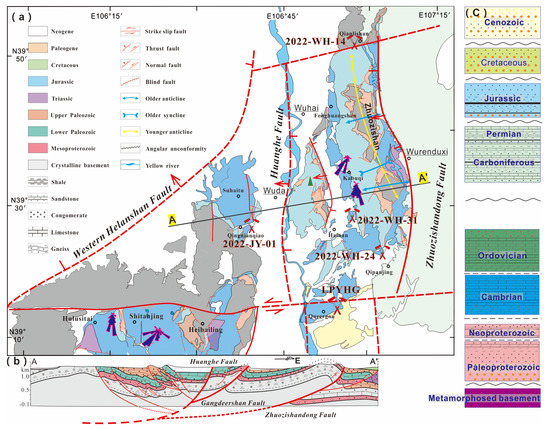
Figure 2.
(a) Regional–scale map showing major faults and folds as well as stratigraphic units and their spatial distribution of the Wuhai Coalfield, with hammer symbols plotting approximal locations of zircon U−Pb dating samples. Paleocurrent data are from Sun and Dong [2]. (b) W−E transection outlining structural architecture of the Wuhai Coalfield (Modified from Yang et al. [20]). (c) Schematic column showing the stratigraphic sequence of the Wuhai Coalfield.
2.2. Stratigraphy and Sedimentary Setting of Carboniferous-Permian Successions
On top of the ca. 2500–1850 Ma high-grade crystalline basement (Figure 2c), Precambrian cover successions of ca. 1800–550 Ma were deposited in alluvial fan to shallow marine settings, as recorded by an upward-fining sequence from alternating conglomerate and gravelly sandstone, via pure quartz sandstone, to thick carbonate assemblages [11], separated by at least two regional disconformities. The early Paleozoic deposition was mostly shallow-water carbonate shelf facies before foreland subsidence at late Ordovician that led to accumulation of carbonate slope to deep-water turbidites within abyssal plain shales [17].
Underlying Jurassic to present alluvial fan to fluvial plain dominated the settings. Carboniferous to Permian sedimentation can be categorized into three environments, shoaling upward from neritic to lacustrine environments (Figure 3 and Figure 4).
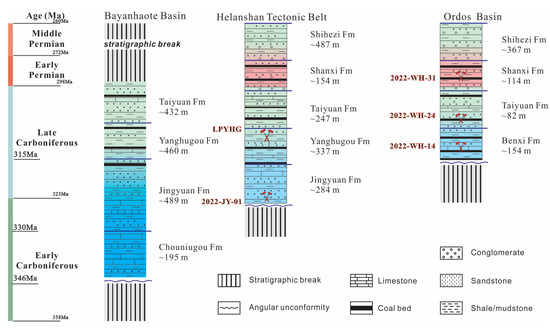
Figure 3.
Stratigraphic sequence and lithologic assemblages of Carboniferous to Permian successions in the Bayanhaote Basin, Helanshan Tectonic Belt, and the Ordos Basin (modified from Sun and Dong [2]).
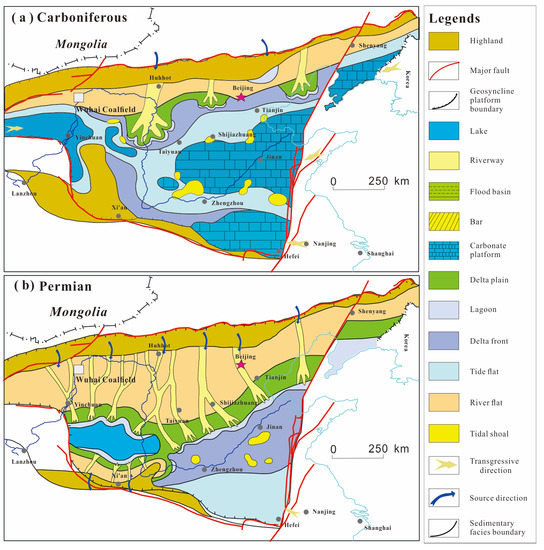
Figure 4.
Overview diagram showing paleogeography of the whole North China Block from Carboniferous (a) to Permian (b) (Modified from Shao et al. [4]).
The lower unit, unconformably overlying the Ordovician limestone (Figure 5a), is characterized by tidal flat to lagoon shales with thin layers of sandstone (Figure 5b) representing sandy flat or barrier island facies. The middle unit, composed of the Taiyuan and Shanxi formations, is the most important coal-bearing level (Figure 5c,d) that has been interpreted to be deposited in delta dominated settings, considering that sandstone layers are mostly thick-massive bedded and display erosive base (Figure 5f). The changing in both quartz to feldspathic arenite in sandstone petrology and deltaic to braided river facies marks the evolving sedimentary environment from the Shanxi to Shihezi Formation (Figure 5g), which terminated the accumulation of coal beds in the Wuhai Coalfield.

Figure 5.
Representative photographs showing stratigraphy and sedimentology of Carboniferous and Permian strata in the Wuhai Coalfield. The positions of sections are labeled in Figure 2a. Scales include geologist (~170 cm tall), hammer (~30 cm long) and car (~3 m wide). (a) Paraconformity separating the underlying Ordovician limestone from the overlying sandstone of the basal Benxi Formation at the Kabuqi Section. (b) Alternation of quartz sandstone and coal-bearing mudstone of the basal Benxi Formation at the Qilishan Section. (c) Overview of the Tiayuan Formation and lower Shanxi Formation, highlighting tidal flat facies characterized by alternation of sandstone and mudstone at the Kabuqi Section. (d) Distant view of the Taiyuan, Shanxi, and Xiashihezi formations at the eastern Zhuozishan. (e) Thick bedded sandstone of the Shanxi Formation at the Kabuqi Section. (f) Thick sandstone depositionally resting upon coal bed of the uppermost Shanxi Formation at the Qilishan Section.
3. Sampling and Analytical Procedures
Up to 37 representative sandstone samples were collected, covering all stratigraphic levels of major coal-bearing formations in the Wuhai Coalfield. Of the samples, 18 medium grained sandstone samples were cut for petrographic thin sections in the laboratory at Northwest University. Major framework grain types were identified one by one and peer-counted under an optical microscope following the procedure of the Gazzi-Dickinson method [23,24], requiring that not less than 400 grains larger than 62.5 μm should be point-counted per slide. Representative photomicrographs are shown in Figure 6. Grain types and petrographic parameters are listed and defined in caption of Supplementary Table S1 listing full information of peer-counting results and recalculated modal data. The Qt-F-L diagram [25] is used to label lithology of these sandstones according to modal composition data (Figure 7a). Modal composition data are labelled on Qt-F-L, Qm-F-Lt and Qp-Lv-Ls ternary diagrams (Figure 7b–d) of Dickinson [24,26] for showing the relation of modal data with tectonic setting of sources.
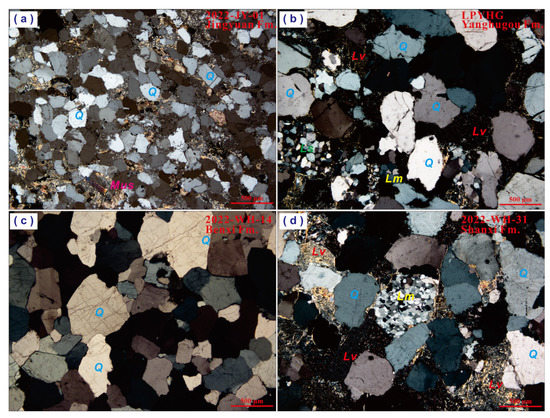
Figure 6.
Representative photomicrographs (cross-polarized light) of Carboniferous to Lower Permian sandstone samples selected for detrital zircon U-Pb geochronology. Sample locations are shown in Figure 2a. See the Supplementary Table S1 for abbreviations of minerals. Sample labels: (a), 2022-JY-01; (b), LPYHG; (c), 2022-WH-14; (d), 2022-WH-31. Abbreviations: Q, Quartz; Lv, volcanic lithics; Lm, metamorphic lithics; Mus, Muscovite.
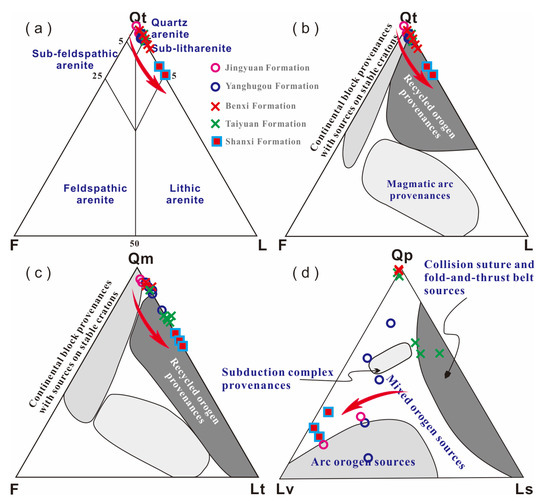
Figure 7.
Standard ternary diagrams for Carboniferous to Lower Permian sandstone modal composition data from the Wuhai Coalfield. Petrologic classification (a) is according to Pettijohn [25]. Provenance fields (b–d) are from Dickinson [26]. Abbreviations: Qt, total quartz; Qm, monocrystalline quartz; Qp, polycrystalline quartz; K, K-feldspar; Pl, plagioclase; L, lithic fragment; Qt = Qm + Qp; F = K + Pl; Lt = L + Qp.
After sandstone petrologic investigations, five samples were selected for detrital zircon U-Pb geochronologic studies. Petrology, stratigraphic levels, and location are listed briefly in Table 1. Dense minerals were retrieved from sandstones and detrital zircon grains were further separated from these accessory minerals using elutriation and magnetic separation techniques at the Langfang Regional Geological Survey. For each sample, about 200 euhedral grains without inclusions and cracks were randomly handpicked and mounted in an epoxy resin disc, and then polished for a smooth, flat surface and coated with carbon. Cathodoluminescence (CL) images were obtained for displaying internal morphology of all zircon crystals, using a Mono CL3+ (Gatan, Pleasanton, CA, USA) attached to a scanning electron microscope (Quanta 400 FEG) at the Micro-Macro Geochemistry Technology (Langfang) Co., Ltd. Representative CL images of the zircons showing spot ages are illustrated in Figure 8. Laser ablation (LA) used the NewWave UP-213 Nd: YAG solid-state laser produced by NewWave company of the United States, and ICP-MS analyses were carried out through an Agilent 7900 plasma mass spectrometer produced by Agilent company of the United States. During the test, Helium was used as carrier gas and Argon was used as compensation gas to adjust the sensitivity. They are mixed and delivered to ICP-MS through a T-shaped joint. The spot size of the laser was set to 30µm. The energy density and frequency were set to 10 J/cm2 and 10 Hz. NIST SRM610 was used to yield highest sensitivity, lowest oxidation and background and stable signal to achieve optimal condition. Signals were collected for 20 s background time, then 40 s sample, and finally, 30 s sample purge time. The peak skipping method was used for data collection. The collection time was 10 ms for 202Hg and 232Th, 20 ms for 204Pb and 206Pb, 30 ms for 207Pb, 15 ms for 208Pb and 238U, and 6 ms for the other elements. Standard zircon 91500 was used as external standard for isotope ratio correction, and standard Plešovice zircon (337 Ma) was used as monitoring blind sample. The international standard sample NIST SRM610 was used as external standard for the correction of trace element contents.

Table 1.
Petrography and sample location of sandstones for zircon U–Pb age dating.
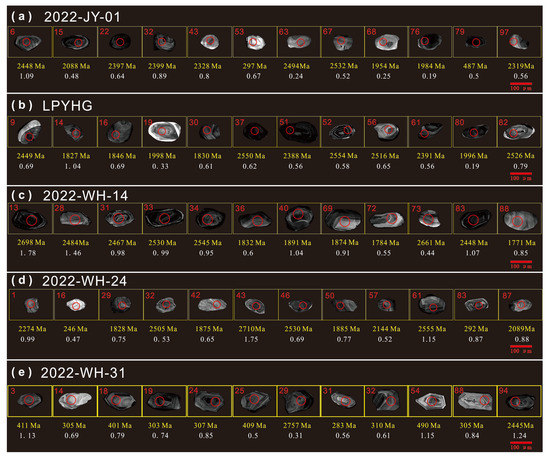
Figure 8.
Representative cathodoluminescence images of analyzed zircons from Carboniferous and Permian samples from the Proto-Helanshan Basin, with red circles showing analytical spots and yellow and white numbers displaying corresponding U-Pb ages and Th/U ratios, respectively. Sample labels: (a), 2022-JY-01; (b), LPYHG; (c), 2022-WH-14; (d), 2022-WH-24; (e), 2022-WH-31.
The GLITTER 4.0 software was used to calculate isotope ratio and element content. The complete analytical data set of zircon U–Pb isotopic compositions and age results are listed in Supplementary Table S2. As ages are younger than 1000 Ma, the 206Pb/238U ages should be adopted, whereas for ages greater than 1000 Ma, we use the 207Pb/206Pb ages according to Black et al. [27]. All results are plotted on concordia plots using ISOPLOT (version 3.0) [28]; however, analyses with discordance greater than 10% are not included in relative age-probability diagrams (Figure 9) for showing a sum of probability distributions of all concordant ages of each sample. Only peaks of age clusters containing several data are robust and would be defined on these diagrams.
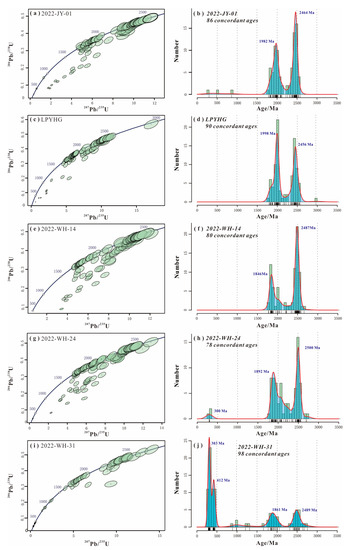
Figure 9.
Concordia diagrams (a,c,e,g,i) showing the results of single-grain zircon U-Pb analyses and frequency (bars) and relative probability density distribution (curves) of ages (b,d,f,h,j) for sandstone samples from Carboniferous and Permian strata. Ellipses show individual analyses. Error ellipses represent 2σ uncertainties.
4. Results
4.1. Sandstone Petrology and Detrital Modal Analysis
In general, Carboniferous to Lower Permian sandstones display immature to submature textures (Figure 6). All fragment grains show irregularly polygonal shapes with clear abrasion surfaces, indicating first-cycle deposition and short-distance transportation. Most of quartz grains are cemented by silica, with variable degrees of calcite cementation selectively replacing matrix and volcanic rock fragments: in places the matrix is replaced by calcite cement.
Except for several samples from the Shanxi Formation being petrologically classified as sub-litharenites, most sandstones collected from the Carboniferous to Lower Permian successions of the Wuhai Coalfield are mineralogically mature to supermature, characterized by the dominance of quartz arenite (Figure 7a). Monocrystalline quartz crystals are prevailing components, making up 48–95% of all framework grains (average 77%). In contrast to rarity of feldspar grains that are absent in most samples, in particular samples from the Yanghugou, Benxi, and Taiyuan formations (Figure 7b,c; Supplementary Table S1), lithic fragments are secondary constituents varying in proportion from 5 to 28% (average 16% including polycrystalline quartz grains). Metamorphic and sedimentary lithics constitute only 1% and 2% amounts of all grains, respectively, while volcanic lithics could constitute up to 19% of all fragment grains (average 5%), slightly lower than percentage polycrystalline quartz grains (average 9%). In addition, amounts of unstable grains clearly increase upwards (Figure 7a–c), as represented by occurrence of 16–18% of volcanic rock lithics and paucity of monocrystalline quartz crystals (48–55%) in the Shanxi Formation.
Modal composition data generally fall in the range of continental block and recycled orogen provenances, showing a trend of increasing amount of sediment contribution from the recycled orogen provenances as a result of dominance of quartz grains and rarity of feldspar grains (Figure 7b,c). The nearly equal amounts of polycrystalline quartz crystals and volcanic lithics, in the Qp-Lv-Ls diagram (Figure 7d), modal data are spread from collision suture to arc orogen sources, with most of them plotting in the range of mixed orogen sources.
4.2. Detrital Zircon U-Pb Geochronology
4.2.1. Zircon Morphology and Origin
The majority of zircon grains selected for single zircon U-Pb dating studies are subhedral to euhedral crystals or broken prisms with low degrees of rounding and sphericity (Figure 9). A small number of crystals display clear abrasion surfaces and are subrounded to rounded in shape, likely indicating multicycle transport. These zircons are mostly large in size. The lengths of most zircon crystals range from ~120 μm to ~240 μm, with aspect ratios of 1:1 to 1:2. Most of dated zircons have high Th/U ratios >0.1 and generally display clear concentric oscillatory zoning, with a small number of grains showing homogeneous, platy, and nebulous structures. Core-rim relations, shown by inherited and/or xenocrystic grains enveloped by narrow rims, can also be observed. The Th/U ratios of most grains, mostly with oscillatory zoning, plate, and sector structures, are greater than 0.4, representing grains formed by magmatic protoliths [29,30]. In contrast, few zircons that display homogeneous internal structures generally have Th/U ratios < 0.1, indicating formation by high-grade metamorphism [29,30].
4.2.2. Zircon U-Pb Age Distribution
(1) Sample 2022-JY-01, Jingyuan Formation
The Sample 2022-JY-01 was collected from the basal Jingyuan Formation at the Qingnianqiao section. Of 100 analyses on the Sample 2022-JY-02, 86 ages with disconcordance less than 10% were obtained (Figure 9). The Mesoproterozoic to Paleozoic ages are rare, with only three samples yielding ages of 297 ± 6, 487 ± 10, and 863 ± 17 Ma. The remaining 83 ages fall in the range of 1783 to 2579 Ma, showing bimodal late Paleoproterozoic and end-Archean to early Paleoproterozoic signatures. The former age cluster consists of 39 ages between 1783 and 2124 Ma, with an age peak at 1982 Ma. The latter, composed of 44 ages, spans in age from 2224 to 2579 Ma and defines an older peak at 2464 Ma.
(2) Sample LPYHG, Yanghugou Formation
Sample LPYHG of the Upper Carboniferous Yanghugou Formation was obtained from the Queergou mining area. Of 100 analyses, 90 results are considered to be reliable, i.e., with concordance of 90–100%, ranging in age from 1791 to 2968 Ma (Figure 9). Except for one grain yielding an age of 2968 Ma, the remaining 89 data are concentrated into two major groups: An older one of 2267–2570 Ma, consisting of 49 ages, displays a peak at 2456 Ma, and a younger one of 1791–2195 Ma, comprising 40 ages, displaying a peak at 1998 Ma.
(3) Sample 2022-WH-14, Benxi Formation
Sample 2022-WH-14 was retrieved from the Upper Carboniferous Benxi Formation of the Qianlishan section. A total of 100 analyses generated 80 concordant results that are all of end-Archean to Paleoproterozoic ages (Figure 9). The 80 ages constitute three clusters. The 29 younger ages range from 1771 to 2094 Ma, defining an age peak at ca. 1846 Ma. A relative smaller age population occurs in the rage of 2204–2339 Ma, which displays a peak of 2214 Ma. Up to 47 ages constituting the largest cluster occurs at 2342–2661 Ma, with tallest peak at 2487 Ma.
(4) Sample 2022-WH-24, Taiyuan Formation
Sample 2022-WH-24 of the Taiyuan Formation was obtained from the Qipanjing mining area. Up to 78 concordant ages were obtained via 100 analyses on 98 zircons, with two grains being analyzed for two times (Figure 9). The 78 concordant ages range from 292 to 2710 Ma. In addition to Late Paleozoic ages of 292, 301, and 309 Ma, most of data are end-Archean to Paleoproterozoic. Besides two oldest ages of 2689 and 2710 Ma, 76 data of 1886–2553 Ma are clustered into two populations of 1782–2089 Ma (34 ages) and 2144–2553 Ma (39 ages), which yield two peaks at ca. 1892 and 2500 Ma, respectively.
(5) Sample 2022-WH-31, Shanxi Formation
Sample 2022-WH-31 of the Shanxi Formation was collected from the Kabuqi section. We undertook 100 analyses on 100 zircons, most of results near the concordia, with 98 ages having disconcordance no larger than 10% and displaying a much wider age span of 283–2757 Ma (Figure 9). Up to 42 zircons are of Precambrian age, including three grains with Neoproterozoic ages of 888–994 Ma, three grains of 1210, 1317, and 1661 Ma, as well as 36 Archean to Paleoproterozoic ages of 1777–2757 Ma. The latter one displays two individual age peaks at ca. 1861 and 2489 Ma. The Paleozoic ages are clustered into two populations. The Early Paleozoic one comprises 22 ages between 399 and 458 Ma, with a smaller peak at 412 Ma. The Late Paleozoic population ranges in age from 293 to 334 Ma, including 34 ages that display a peak at ca. 303 Ma.
5. Discussion
5.1. Provenance Interpretations
Paleocurrent reconstruction data from Carboniferous and Permian sections in the Wuhai Coalfield display generally southward-flowing directions (Figure 2), indicating sediment supply from the north. This inference is consistent with paleogeographic reconstructions that yielded a southward-deepening paleogeography [2,5] and conglomerates of the Benxi and Shanxi formations that become fine southward and die out at the Kabuqi and Qipanjing localities.
As the Wuhai Coalfield is located at the conjunction of the IMCA to the north, the Alxa to the west and the Qilian orogen to the south, we firstly should evaluate potential contributions from each one. In the diagram showing comparison of age distribution between samples and potential sources (Figure 10) mentioned previously, it is clear that the Qilian and Alxa sources are not possible, because the prominent Meso- to Neoproterozoic age clusters in both sources [14] are not represented in our samples in addition to only a small amount of zircons with ages of 1500–800 Ma in the Sample 2022-WH-31 from the Shanxi Formation. Together with known paleocurrent reconstruction data that require a northerly provenance, we do not regard the Alxa and Qilian sources as candidates. Although variation in frequency of age clusters and amount of younger Paleozoic components exists (Figure 9), all the five sampled sandstones contain a large number of Neoarchean to Paleoproterozoic ages that individuate two main age peaks at ca. 2400 and 1900 Ma (Figure 10), suggesting that basement rocks of the NCB shed most of detrital materials to the study area [31,32,33,34]. However, some Paleozoic zircons clearly indicate additional influx from younger arc-related assemblages [35,36].
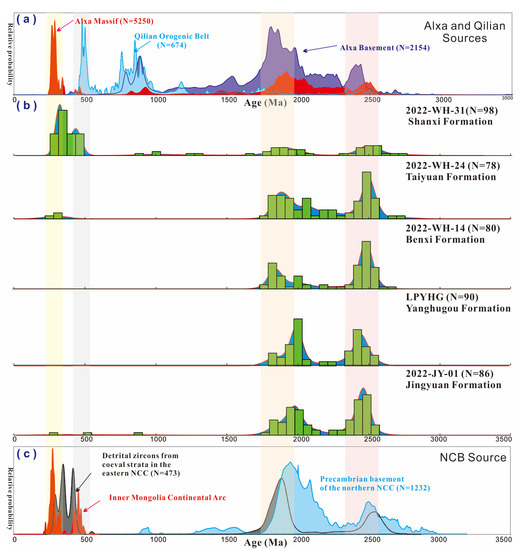
Figure 10.
Probability density distribution (curves) of ages for the Alxa and Qilian sources (a), sandstones from Carboniferous to Permian successions (b) in the Wuhai Coalfield, and (c) the North China Block. Data for the Alxa, Qilian, and NCB basement sources are from Sun and Dong [2,17].
Sandstone modal composition data show that sources for the Carboniferous to Permian sandstones (Figure 7) are composed of various lithological blocks, showing characteristics of both stable craton and mixed orogen sources that include contributions from arc orogens and collision belts (Figure 7d). The IMCA was constructed on top of the northern NCB basement, thus, its Precambrian basement contains rocks that display bimodal early and late Paleoproterozoic signatures [32], matching well with both the NCB basement and coeval samples sourced from the IMCA (Figure 10). The younger ages, mostly in Sample 2022-WH-31 of the Shanxi Formation, with only three ages of 297 ± 6, 487 ± 10, and 863 ± 17 Ma in Sample 2022-JY-01, imply important clastic addition from arc materials. In particular, the only Neoproterozoic grain may suggest limited sediment distribution from the Bainaimiao Arc [2]. The dominant Paleozoic ages of younger zircons should be attributed to erosion of large areas of the Paleozoic plutonic bodies in the IMCA, in response to protracted south-dipping subduction of the Solonker Oceanic lithosphere [34,35,36,37]. Also, the two major Paleozoic age populations of ca. 450–400 and 320–270 Ma correspond to high-flux events in the IMCA [17,33].
However, we cannot conclusively distinguish whether the older Neoarchean to Paleoproterozoic zircons were derived from the northern edge of the NCB basement or basement of the IMCA, because the Paleozoic IMCA was built upon the NCB crystalline basement, and both might have been dominant sources. However, we can conclude that the Neoproterozoic Bainaimiao Arc in the oceanward portion of the IMCA may have not been intensely uplifted, and its feeding of detritus to the hinterland NCB basin was hindered by the North China active margin, which would have been a significant highland then.
In ascending order, composition of lithic fragments (Figure 7) and Paleozoic zircons (Figure 10) vary considerably, as the lower four samples are mostly quartz arenites containing few or no ages younger than 1000 Ma in their age spectra, whereas the sample 2022-WH-31 from the Shanxi Formation comprises considerable number of Paleozoic zircons and lithic fragments. This trend may indicate (1) increasing sediment input from the IMCA instead of former northern NCB basement, (2) unroofing of the IMCA to its arc batholith where late Paleozoic granites are abundant.
5.2. A Note on Tectonic Affinity between the Ordos Block and the Alxa Massif
Before discussing on dynamic mechanism for the evolving basin-infill of the northwestern NCB, wherein the Wuhai Coalfield is located at, we need to clarify some details with regard to the tectonic affinity between the Ordos Block and the Alxa Tectonic Belt in the Carboniferous to Permian. In some recent literatures, a mid-Mesozoic suture or transform fault that welded the Alxa Massif and the Ordos Block has been placed to either the western [8,38,39] or eastern side [40] of the Helanshan Tectonic Belt, which would predict the occurrence of a Late Paleozoic Ocean within or directly to the western margin of the Wuhai Coalfield.
Subduction and closure of such an ocean during early-Mesozoic would have resulted in significantly distinct stratigraphic sequence and paleogeography in basins on its both sides. However, no related stratigraphic clues can be found, as throughout the Bayanhaote basin, Helanshan Tectonic Belt, and the Zhuozishan of the northwestern Ordos Block display consistent Carboniferous to Permian lithologic assemblages and sequence (Figure 3), dominated by shallow marine and deltaic facies transported by consistent south- to southwest- flowing paleodrainage systems, instead of east- and west- flowing systems to the assumed ocean.
In addition, none of the Carboniferous to Permian successions in the three tectonic units has been metamorphosed, and there are no signs of arc-related records, such as plutonism and massive volcanism, having been found also, which should be required to exist in at least one side of the ocean prior to its closure in the mid-Mesozoic.
In conclusion, we argue here that at least in the Wuhai Coalfield and its adjacent regions, Carboniferous to Permian sedimentary related records do not support the existence of such an ocean nor a mid-Mesozoic amalgamation between the Alxa Massif and the Ordos Block. Therefore, we agree with the models proposed by Sun and Dong [12,14,15] that suggest the Alxa Massif should have been the western extension of the NCB during the Phanerozoic and that the Wuhai Coalfield and its surrounding regions should occupy an intracontinental position at the northwestern portion of the NCB [2,17].
5.3. Late Paleozoic Back-Arc Coal Beds Accumulation in Response to South-Dipping Subduction of the Southern PAO
Previous geologic concerns on the Late Paleozoic paleogeography and basin-fill processes of the western NCB generally focused on lithologic assemblages and depositional environments, with an important conclusion that deciphers an evolving depositional trend from Carboniferous epicontinental sea, via earliest Permian marine delta to alluvial fan-fluvial plain [4,5,6,7,41]. Conversely, the dynamic mechanism along with the tectonic setting that triggered those polyphase transitions remain still unclear, with an ambiguous cratonic basin model being generally invoked in those paleogeographic interpretations.
However, modal composition data consistently indicate a rather complex and mixed source that is composed of arc orogen, continental block and recycled orogen provenances (Figure 7b–d), significantly different from sediments accumulated in intracraton basins. In particular, most of those samples show low textural but supermature compositional maturity (Figure 6), which can be ascribed to either a quartz enriched source or extreme weathering that removed all feldspars and lithics before deposition in the study area after short-distance transportation.
More direct evidences come from our new detrital zircon U-Pb geochronologic data. In the Sample 2022-JY-01 of the Jingyuan Formation, two grains have crystallization ages of 297 ± 6 and 487 ± 10 Ma. The Sample 2022-WH-31 of the Shanxi Formation contains more zircons of Paleozoic ages, including 22 data between 399 and 458 Ma and 34 ages of 293–334 Ma. Those Paleozoic arc derived materials indicate sediment contributions from a juvenile magmatic arc. The older ages that correspond well with basement rocks of the northern NCB basement refer to the basement rocks the arc was constructed upon. Moreover, similar studies on coeval successions in the adjacent Helanshan Tectonic Belt also revealed abundant Carboniferous and Permian zircons mixed with zircons with crystallization ages close to the deposition ages of their host sediments [2]. Therefore, we argue here that Carboniferous to Permian basin fill in the western NCB should be associated with evolution of a continental arc bordering the northern NCB. The minor amount of sediment lithics can be reasonably explained by sediment recycling from underlying successions, mostly carbonate rocks. In addition, identification of a subduction-induced diabase 304 ± 3 Ma in the northern Helanshan (Figure 2a) and volcanic detritus in synchronous deposits of the whole NCB [9] hints that the basement of the northwestern Ordos should have been influenced by subduction of the southern PAO lithosphere [42]. Thus, we consider that paleogeography and basin evolution of the northwestern NCB should be back-arc responses to southward subduction of the Paleo-Asian Ocean (Figure 11a).
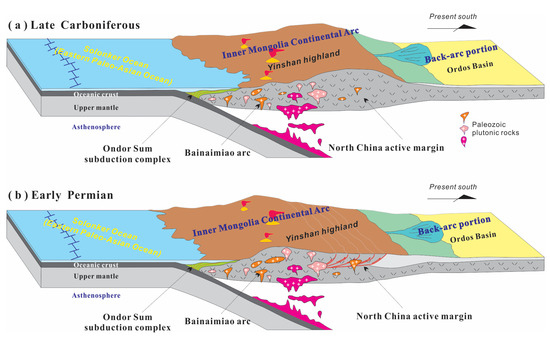
Figure 11.
Schematic model showing the paleogeographic transition in the western North China Block during Carboniferous and Early Permian (modified from Sun and Dong [2]). Notes: The Carboniferous sources of the Ordos Basin were dominated by the NCB basement with rare supply from arc magmatic rocks (a), whereas uplift of the Inner Mongolia Continental Arc triggered a large volume of sediment influx by eroding Paleozoic arc pluton bodies since the Early Permian deposition of the Shanxi Formation (b).
Notably, sandstone composition (Figure 7) and detrital zircon age (Figure 10) show a major change at the beginning of the Shanxi Formation deposition, represented by increasing amounts of sediment supply from arc plutons. We view this as an important indicator of the elevation and outward expansion of the IMCA (Figure 11b), the hinterland of which should be topographically higher than its previous frontal part, where Neoarchean and Paleoproterozoic basement rocks are dominant sources for the older successions in the study area.
6. Conclusions
The data presented in this paper, along with complied geological observations in the study area and adjacent continental arc system, allow the following major conclusions to be drawn:
- (1)
- The Carboniferous to Permian successions were accumulated in a shallow marine to delta setting, with sources from the IMCA in the north.
- (2)
- In the Wuhai Coalfield, detrital zircon spectra for its western portion in the northern Helanshan and its western portion in the Zhuozishan are comparable, indicating a linked paleogeography throughout the Carboniferous to early Permian and arguing against the possibility of an ocean bordering the northwestern NCB.
- (3)
- An upward increase in both lithic fragments and detrital zircons with ages close to depositional ages of the host sediment demonstrates evolving sources from the northern NCB basement to farther north sources in the IMCA hinterland.
- (4)
- The accumulation of coal beds in the Wuhai Coalfield and paleogeographic evolution of the northwestern NCB are likely back-arc responses to southward subduction of the Paleo-Asian Ocean.
Supplementary Materials
The following supporting information can be downloaded at: https://www.mdpi.com/article/10.3390/en16010034/s1. Table S1: Peer-counting results and recalculated modal data for framework grain composition of Carboniferous and Permian sandstones from the Wuhai Coalfield; Table S2: Laser ablation inductively coupled plasma spectrometry (LA-ICP-MS) data of detrital zircons from Carboniferous and Permian sandstones from the Wuhai Coalfield.
Author Contributions
Conceptualization, J.S. and J.L.; methodology, J.S. and J.L.; software, J.L.; validation, J.S.; formal analysis, Q.C., F.K., Y.M., T.W. and Q.Z.; investigation, J.L., J.S., Q.C., F.K., Y.M., T.W., Q.Z., W.H., L.H. and Y.Q.; data curation, J.S. and J.L.; writing—original draft preparation, J.S. and J.L.; writing—review and editing, J.L., J.S., Q.C., F.K., Y.M., T.W., Q.Z., W.H., L.H. and Y.Q.; supervision, J.S.; project administration, J.S. and J.L.; funding acquisition, J.S. and J.L. All authors have read and agreed to the published version of the manuscript.
Funding
Financial support for this study was jointly given by the NSFC (Grants: 41930217, 42072260 and 41602109), Foundation of State Key Laboratory of Petroleum Resources and Prospecting, China University of Petroleum, Beijing (No. PRP/open-2007), and Natural Science Basic Research Program of Shaanxi (Program No. 2021JM-158).
Data Availability Statement
All data related to this manuscript, including sandstone modal composition, sampling location and zircon U-Pb dating are included in the article/Supplementary Materials, further inquiries are available upon request by contact with the corresponding author.
Acknowledgments
The authors would like to acknowledge editors and anonymous reviewers for insightful comments that led to a better version of our work. The first author (J.L.) sincerely appreciates Peng Zhang for his life-long accompany and care, without which this work could not be finished.
Conflicts of Interest
The authors declare no conflict of interest.
References
- Sun, J.P.; Dong, Y.P. Middle-Late Triassic sedimentation in the Helanshan Tectonic Belt: Constrain on the tectono-sedimentary evolution of the Ordos Basin, North China. Geosci. Front. 2019, 10, 213–227. [Google Scholar] [CrossRef]
- Sun, J.P.; Dong, Y.P. Stratigraphy and geochronology of the Permo-Carboniferous strata in the Western North China Craton: Insights into the tectonic evolution of the southern Paleo-Asian Ocean. Gondwana Res. 2020, 88, 201–219. [Google Scholar] [CrossRef]
- Li, W.H.; Pang, J.G.; Cao, H.X.; Xiao, L.; Wang, R.G. Depositional system and paleogeographic evolution of the late Triassic Yangchang stage in Ordos Basin. J. Northwest Univ. 2009, 39, 501–506. [Google Scholar]
- Shao, L.Y.; Dong, D.X.; Li, M.P.; Wang, H.S.; Wang, D.D.; Lu, J.; Zheng, M.Q.; Cheng, A.G. Sequence-paleogeography and coal accumulation of the Carboniferous-Permian in the North China Basin. J. China Coal Soc. 2014, 39, 1725–1734. [Google Scholar]
- Guo, Y.Q.; Li, W.H.; Guo, C.B.; Zhang, Q.; Chen, Q.; Wang, R.G.; Liu, X.; Ma, Y.; Li, Z.C.; Zhang, M.T.; et al. Sedimentary systems and palaeogeography evolution of Ordos Basin. J. Palaeogeogr. 2019, 21, 293–320. [Google Scholar]
- Chen, S.Y.; Liu, H.J. Sea-level changes in North China during the Late Paleozoic. Sediment. Facies Palaeo Geogr. 1995, 5, 14–21. [Google Scholar]
- Chen, S.Y.; Liu, H.J. Sequence stratigraphic framework and its characteristics of the Carboniferous-Permian in North China. Acta Sedimentol. Sin. 1999, 17, 63–80. [Google Scholar]
- Wang, M.; Zhong, Y.T.; He, B.; Denyszyn, S.W.; Wang, J.; Xu, Y.G. Geochronology and geochemistry of the fossil-flora-bearing Wuda Tuff in North China Craton and its tectonic implications. Lithos 2020, 364, 364–365. [Google Scholar] [CrossRef]
- Cui, H.; Zhu, S.F.; Tan, M.X.; Tong, H. Depositional and diagenetic processes in volcanic matrix-rich sandstones from the Shanxi and Shihezi formations, Ordos Basin, China: Implication for volcano-sedimentary systems. Basin Res. 2022, 34, 1859–1893. [Google Scholar] [CrossRef]
- Sun, J.P.; Yang, L.; Dong, Y.P.; Yang, X.Y.; Peng, Y.; Zhao, J. Permian tectonic evolution of the southwestern Ordos Basin, North China: Integrating constraints from sandstone petrology and detrital zircon geochronology. Geol. J. 2020, 55, 8068–8091. [Google Scholar] [CrossRef]
- Sun, J.P.; Dong, Y.P.; Chen, Q.; Yang, L.; Li, W.H.; Zhang, D.D.; Zhang, Q. Ordovician tectonic transition from passive margin into peripheral foreland in the southern Ordos: A diagnostic insight into the closure of Erlangping Ocean between the North Qinling Arc and North China Block. Basin Res. 2022, 1–27. [Google Scholar] [CrossRef]
- Zhao, G.C.; Cawood, P.A.; Wilde, S.A.; Sun, M.; Zhang, J.; He, Y.H.; Yin, C.Q. Amalgamation of the North China Craton: Key issues and discussion. Precambrian Res. 2012, 222–223, 55–76. [Google Scholar] [CrossRef]
- Zhao, G.C.; Wang, Y.J.; Huang, B.C.; Dong, Y.P.; Li, G.W.; Zhang, S.Y. Geological reconstructions of the East Asian blocks: From the breakup of Rodinia to the assembly of Pangea. Earth Sci. Rev. 2018, 186, 262–286. [Google Scholar] [CrossRef]
- Sun, J.P.; Dong, Y.P. Triassic tectonic interactions between the Alxa Massif and Ordos Basin: Evidence from integrated provenance analyses on sandstones, North China. J. Asian Earth Sci. 2019, 169, 162–181. [Google Scholar] [CrossRef]
- Sun, J.P.; Dong, Y.P. Cambrian tectonic evolution of the northwestern Ordos Terrane, North China: Constraints of stratigraphy, sedimentology and zircon U–Pb geochronology. Int. J. Earth Sci. 2019, 108, 569–586. [Google Scholar] [CrossRef]
- Dong, Y.P.; Sun, S.S.; Santosh, M.; Zhao, J.; Sun, J.P.; He, D.F.; Shi, X.H.; Hui, B.; Cheng, C.; Zhang, G.W. Central China Orogenic Belt and amalgamation of East Asian continents. Gondwana Res. 2021, 100, 131–194. [Google Scholar] [CrossRef]
- Sun, J.P.; Dong, Y.P. Ordovician tectonic shift in the western North China Craton constrained by stratigraphic and geochronological analyses. Basin Res. 2020, 32, 1413–1440. [Google Scholar] [CrossRef]
- Sun, J.P.; Dong, Y.P.; Ma, L.C.; Chen, S.Y.; Jiang, W. Devonian to Triassic tectonic evolution and basin transition in the East Kunlun–Qaidam area, northern Tibetan Plateau: Constraints from stratigraphy and detrital zircon U–Pb geochronology. GSA Bull. 2022, 134, 1967–1993. [Google Scholar] [CrossRef]
- Yang, X.Y. The Study of the Deformation Characteristic of the Helanshan Tectonic Belts. Doctor’s Thesis, Northwest University, Xi’an, China, 2018. [Google Scholar]
- Yang, X.Y.; Dong, Y.P. Mesozoic and Cenozoic multiple deformations in the Helanshan Tectonic Belt, Northern China. Gondwana Res. 2018, 60, 34–53. [Google Scholar] [CrossRef]
- Yang, X.Y.; Dong, Y.P. Multiple phases of deformation in the southern Helanshan tectonic Belt, northern China. J. Asian Earth Sci. 2020, 201, 104497. [Google Scholar] [CrossRef]
- Yang, X.Y.; Dong, Y.P.; Xiang, L.Z.; Feng, Y.B.; Liu, D.S.; Luo, L.; Li, D.; Li, X.L.; Shen, N.; Tang, L.Q.; et al. Two phases of Cenozoic deformation in the Wudu Basin, West Qinling (Central China): Implications for outward expansion of the Tibetan Plateau. J. Asian Earth Sci. 2022, 229, 105152. [Google Scholar] [CrossRef]
- Ingersoll, R.V.; Fullard, T.F.; Ford, R.L.; Grimm, J.P.; Pickle, J.D.; Sares, S.W. The effect of grain size on detrital modes: A test of the Gazzi-Dickinson point-counting method. J. Sediment. Res. 1984, 54, 103–116. [Google Scholar]
- Dickinson, W.R. Interpreting provenance relations from detrital modes of sandstones. In Provenance of Arenites; Zuffa, G.G., Ed.; Springer: Berlin/Heidelberg, Germany, 1985; Volume 148, pp. 333–361. [Google Scholar]
- Pettijohn, F.J. Sedimentary Rocks, 3rd ed.; Harper and Row: New York, NY, USA, 1975. [Google Scholar]
- Dickinson, W.R. Provenance and sediment dispersal in relation to paleotectonics and paleogeography of sedimentary basins. In New Perspectives in Basin Analysis; Frontiers in Sedimentary Geology; Kleinspehn, K.L., Paola, C., Eds.; Springer: New York, NY, USA, 1988; pp. 3–25. [Google Scholar]
- Black, L.P.; Kamo, S.L.; Allen, C.M.; Aleinikoff, J.N.; Davis, D.W.; Korsch, R.J.; Foudoulis, C. TEMORA 1: A new zircon standard for Phanerozoic U-Pb geochronology. Chem. Geol. 2003, 200, 155–170. [Google Scholar] [CrossRef]
- Ludwig, K.R. User’s Manual for Isoplot 3.00: A Geochronological Toolkit for Microsoft Excel. Berkeley Geochronology Center Special Publication: Berkeley, CA, USA,, 2003; Volume 4, p. 70. [Google Scholar]
- Belousova, E.; Griffin, W.; O’Reilly, S.Y.; Fisher, N. Igneous zircon: Trace element composition as an indicator of source rock type. Contrib. Mineral. Petrol. 2002, 143, 602–622. [Google Scholar] [CrossRef]
- Corfu, F.; Hanchar, J.M.; Hoskin, P.W.O.; Kinny, P. Atlas of zircon textures. Rev. Mineral. Geochem. 2003, 53, 469–500. [Google Scholar] [CrossRef]
- Cope, T.; Ritts, B.; Darby, B.; Fildani, A.; Graham, S. Late Paleozoic Sedimentation on the Northern Margin of the North China Block: Implications for Regional Tectonics and Climate Change. Int. Geol. Rev. 2005, 47, 270–296. [Google Scholar] [CrossRef]
- Zhang, S.H.; Zhao, Y.; Kröner, A.; Liu, X.M.; Xie, L.W.; Chen, F.K. Early Permian plutons from the northern North China Block: Constraints on continental arc evolution and convergent margin magmatism related to the Central Asian Orogenic Belt. Int. J. Earth Sci. 2009, 98, 1441–1467. [Google Scholar] [CrossRef]
- Eizenhöfer, P.R.; Zhao, G.C. Solonker Suture in East Asia and its bearing on the final closure of the eastern segment of the Palaeo-Asian Ocean. Earth-Sci. Rev. 2018, 186, 153–172. [Google Scholar] [CrossRef]
- Eizenhöfer, P.R.; Zhao, G.C.; Zhang, J.; Sun, M. Final closure of the Paleo-Asian Ocean along the Solonker Suture Zone: Constraints from geochronological and geochemical data of Permian volcanic and sedimentary rocks. Tectonics 2014, 33, 441–463. [Google Scholar] [CrossRef]
- Eizenhöfer, P.R.; Zhao, G.C.; Sun, M.; Zhang, J.; Han, Y.G.; Hou, W.Z. Geochronological and Hf isotopic variability of detrital zircons in Paleozoic strata across the accretionary collision zone between the North China craton and Mongolian arcs and tectonic implications. Geol. Soc. Am. Bull. 2015, 127, 1422–1436. [Google Scholar] [CrossRef]
- Jian, P.; Liu, D.; Kröner, A.; Windley, B.F.; Shi, Y.; Zhang, W.; Tomurhuu, D. Evolution of a Permian intraoceanic arc-trench system in the Solonker suture zone, Central Asian Orogenic Belt, China and Mongolia. Lithos 2010, 118, 169–190. [Google Scholar] [CrossRef]
- Cope, T. Phanerozoic magmatic tempos of North China. Earth Planet. Sci. Lett. 2017, 468, 1–10. [Google Scholar] [CrossRef]
- Ge, X.H.; Ma, W.P.; Liu, J.L.; Ren, S.M.; Liu, Y.J.; Yuan, S.H.; Wang, M.P. A discussion on the tectonic framework of Chinese mainland. Geol. China 2009, 36, 949–965. [Google Scholar]
- Wan, T.F. Discussion on the Liupanshan-Helanshan Collision Zone. Geotecton. Metallog. 2020, 44, 845–851, (In Chinese with English abstract). [Google Scholar]
- Yuan, W.; Yang, Z.Y. The Alashan Terrane did not amalgamate with North China block by the late Permian: Evidence from Carboniferous and Permian paleomagnetic results. J. Asian Earth Sci. 2015, 104, 145–159. [Google Scholar] [CrossRef]
- Jia, J.H.; Liu, H.J.; Guo, Y.H. Late Carboniferous Depositional Systems and High Resolution Sequence Cycles of the Western Ordos Basin—Taking Hulusitai Section as an example. Acta Sedimentol. Sin. 1999, 3, 397–402, (In Chinese with English abstract). [Google Scholar]
- Wang, Z.N. The Geochronology, Geochemistry and Tectonic Implications of Mafic Rocks in Helan Mountains. Master’s Thesis, Northwest University, Xi’an, China, 2018. [Google Scholar]
Disclaimer/Publisher’s Note: The statements, opinions and data contained in all publications are solely those of the individual author(s) and contributor(s) and not of MDPI and/or the editor(s). MDPI and/or the editor(s) disclaim responsibility for any injury to people or property resulting from any ideas, methods, instructions or products referred to in the content. |
© 2022 by the authors. Licensee MDPI, Basel, Switzerland. This article is an open access article distributed under the terms and conditions of the Creative Commons Attribution (CC BY) license (https://creativecommons.org/licenses/by/4.0/).